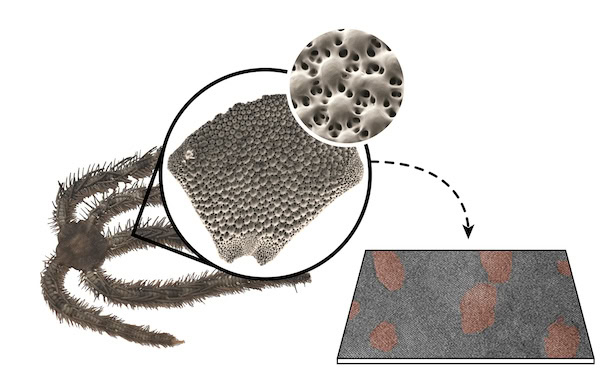
[Image above] A mixture of images of a brittle star, its dorsal arm plate, and a TEM image of the lattice with nanodomains. Credit: ESRF; Iryna Polishchuk
There’s a lot to learn about the animal kingdom that lives and thrives in the depths of the oceans. As a scuba diver, I’m fascinated by the activity in underwater communities I’m privileged to witness each time my husband and I go on a dive.
Apparently, scientists are learning a lot from underwater life as well. Earlier this year we reported on how sea sponges create their own glass structures. And we also learned that these sea sponges use an internal protein filament to determine what their silica spicules will be shaped like.
Now, another sea creature is taking center stage to teach scientists about making glass and ceramics a lot more durable. A brittle starfish, Ophiocoma wendtii, has inspired researchers to use the European Synchrotron Radiation Facility in Grenoble, France, to explore how this delicate creature can create tempered glass-like materials underwater.
Boaz Pokroy, associate professor in the Department of Materials Science and Engineering at Technion-Israel Institute of Technology, and a team of international scientists have been studying the crystalline structure and capabilities of the little starfish for the past few years.
Years ago, scientists who conducted previous research found that O. wendtii has hundreds of microscopic lenses on its arms that enable it to detect dark areas underwater to hide from predators. The starfish creates these hard lenses, similar to tempered glass, underwater at cold temperatures.

Ophiocoma wendtii. Credit: ESRF
Unlike O. wendtii’s process, tempered glass is created by heating glass to at least 600o C (1,112o F) and then cooling it under high pressure. The outer surface cools more quickly than the center, compressing it and making it more compact and sturdier than regular glass.
So how do O. wendtii make their strong lenses without this heating and cooling process?
“We have discovered a strategy for making brittle material much more durable under natural conditions,” Pokroy explains in an ESRF news release. “It is ‘crystal engineering’ and tempering without heating and quenching—a process that could be very useful in materials engineering.” According to the paper’s abstract, the toughening process is similar to Guinier-Preston zones in metallurgy.
Using X-ray diffraction, the team discovered how the lenses were formed from calcite after they heated the material in powder form. “We understood that we had nanodomains after this experiment,” Pokroy adds, “so we did some transmission electron microscopy at home, then came to ID13 to map the nanodomains and finally to ID16 to do tomography on how the different particles arrange themselves in different layers.”
The most important stage during formation of O. wendtii’s lenses is the transition from the amorphous phase to crystalline phase, according to the release. This is where low-density magnesium-rich calcite nanoparticles separate from the rest of the material, creating different concentrations of magnesium in the calcite particles, resulting in varying degrees of hardness, density, and pressure in different areas of the material. It’s the magnesium that’s responsible for compressing and crystallizing (“tempering”) the lenses into a clear, hard material.
The research could result in new strategies for toughening synthetic ceramic materials in a number of applications, including optical lenses and biomaterial implants.
The paper, published in Science, is “Coherently aligned nanoparticles within a biogenic single crystal: A biological prestressing strategy” (DOI: 10.1126/science.aaj2156).
Did you find this article interesting? Subscribe to the Ceramic Tech Today newsletter to continue to read more articles about the latest news in the ceramic and glass industry! Visit this link to get started.
Author
Faye Oney
CTT Categories
- Basic Science
- Biomaterials & Medical
- Environment
- Glass
- Material Innovations
- Nanomaterials
- Optics


